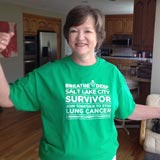By Jan Poulsen, Guest Blogger
We have all heard many times that smoking is the leading cause of lung cancer. But did you know that the second leading cause of lung cancer is radon gas? Each year, approximately 160,000 Americans die from lung cancer, and about 22,000 of those die from radon-induced lung cancer.
My name is Jan Poulsen, and I am a lung cancer survivor. I want to share my story in the hopes that it might prevent even one person from getting lung cancer.
I’m one of those people whose lung cancer was caused by exposure to high levels of radon in their home. In May 2007, I got a phone call from the doctor who had performed a biopsy on a mass in my lung. He said, “I am sorry to tell you that you have lung cancer, and it is inoperable. I would say you have about four months to live.”
Lung cancer? But I had never smoked!
I made an appointment with an oncologist, and the next thing, I knew, I was in the hospital about to have my entire right lung removed. I underwent radiation and chemotherapy treatments following the surgery. It took some time, but I slowly got my strength back. I was found cancer-free after five years and released. Then, during my sixth year of remission, an MRI showed a very large tumor in the front of my brain and a smaller tumor in the back of my brain, most likely due to the spread of the lung cancer. I had brain surgery to remove the large tumor, and a month later had a radiation procedure, to remove the smaller tumor. I was in remission until last November, when I had to have the radiation procedure again to remove 6 more tumors from my brain. I am currently undergoing a new treatment that is working well for me.
Lung cancer is the “bad boy” of cancers. It is the deadliest of all cancers and kills more people annually than the next four cancers — breast, colon, pancreatic, and prostate — combined. People assume that if you have lung cancer, you must be a smoker, but that’s not true. There are no routine screenings for lung cancer, and many times there are no symptoms. So by the time it is detected, it is at stage 3 or 4 and has already spread.
So how does radon fit into the picture?
Radon is a naturally occurring gas caused by the decomposition of uranium-bearing granite in our soil. It is all around us, but becomes dangerous when it becomes concentrated in our airtight homes. You can’t see, smell, or taste it, and unlike carbon monoxide, it does not make you sick immediately.
As I said earlier, my lung cancer was caused by radon gas. Shortly after my diagnosis, we had our home tested for radon. An earlier test when we bought the home came in at 2.2 pc/l. After a big remodel and digging a walk-out basement, our second test came back at 24.9 pc/l, six times the EPA-recommended action level! Apparently disturbing the soil and knocking out walls created new avenues for radon to enter our home. We had a mitigation system installed, which brought our radon level down to 1.7 pc/l.
The only way to know if your home is safe from radon is to test it. There is an easy short-term test that you can order from the Department of Environmental Quality. The kit costs about $8 and includes the processing fee. Just follow the directions on the package, leave it in your basement or lowest level of your home for two to four days, mail it in, and wait for the company to email you the results. If the level is higher than 4.0 picocuries/liter of air, you will want to contact a certified radon mitigation expert to do further testing or install a radon mitigation system.
Mitigation isn’t as expensive as you may think. It can typically can be done for $1500 or less. The cost of my lung cancer treatment to date is running upwards of $1.25 million, so mitigation is pretty cost-effective if you think about it.
So please test your home for radon. Preventing lung cancer is so much easier and less costly than treating lung cancer.

I am currently retired, but I spent over 20 years as a travel agent, and was a volunteer at school, church, and with the Cottonwood Heights Figure Skating Club. For ten years, I managed the only synchronized skating team in Utah. My husband is a pediatric dentist, and we have two grown daughters. No grandchildren, but three granddogs! I had to retire from the travel industry and my volunteer work when I was diagnosed with lung cancer. Now my mission is to again volunteer, but this time I hope to be saving lives by sharing my story about how radon has affected my life. I am a proud member of the Utah Radon Coalition and the Utah Radon Policy Coalition, and a local advocate and organizer for LUNGevity.
DEQ invites guest bloggers to share their thoughts on issues that impact our environment. We appreciate their insights and the opportunity to broaden the conversation with others in the community.

